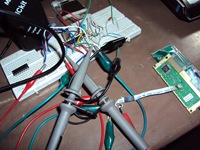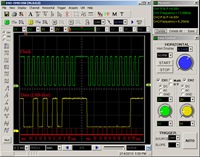Before I dive into this post I take a moment to profusely apologize for the title of the post – it is tragically horrendous.
OK, so now that I’ve got that out of the way, lemme begin. This post is a little out of ‘order’; it would have been more appropriate had I first blogged about how I procured some of the components mentioned in this post. But heck! Lazy as I am, I guess I’ll leave that for a later date.
A friend of mine (un)fortunately busted his laptop several months back. I managed to persuade him to let me scavenge parts from the laptop. What parts did I get? That’ll be the subject of a different post :-D I managed to rescue several components; a touchpad being one of them. And as usual, I went about trying to interface it.
Electronics being my love, and today being Valentine’s Day, it is most fitting that I have successfully managed to communicate with the touchpad. Now before you start making judgements about me, and why I fool about with electronics on this most awesome day, let me tell you how I went about the interfacing.
The touchpad is a mouse replacement ubiquitous on laptops. Synaptics is by far, the biggest touchpad manufacturer. Alps Electric, Cypress, and a few others are also into the touchpad market. Most touchpads today work on the principle of capacitive sensing.
 The touchpad of my trusty IBM Thinkpad R51
The touchpad of my trusty IBM Thinkpad R51
The touchpad I scavenged was from an HP Pavilion dv2000 series laptop. The touchpad used is probably manufactured by Alps Electric Corporation (there is a prominent “ALPS” silkscreened onto the back of the PCB). The touchpad is a capacitive sensing type and is controlled by a 48 pin QFP. The chip is marked 1CA026A. I googled high and I googled low but I couldn’t find anything useful; no datasheets, nothing. So it became necessary that I give experimentation a shot.
There is a four wire flat cable (FFC) heading off the PCB. Having fooled about with electronics for a while now, I knew that it was but obvious that the touchpad used some sort of serial protocol. I figured that there were a few possibilities – maybe USB, possibly I2C. Again, I googled to see if touchpads followed a standard protocol. Most sites on the net said that laptop touchpads invariably use the PS/2 protocol, however, none of them said it with ‘authority’. It was always “apparently, touchpads use the PS/2 protocol” or “the PS/2 protocol is used even on laptops”.
Anyway, I thought I’d give USB a try. I used a hacked-together USB dev board, pulled out V+, Gnd, D+, D-, and connected them to what seemed like the appropriate pins on the touchpad. When the error “USB device not recognized” popped up, I reversed D+ and D-. After I still got the same error, I guessed that it was the PS/2 protocol that the device used.
I don’t have a PS/2-to-USB converter so I had to use one of my trusty PICs (a ‘628A is this case) to emulate a PS/2 host. I wrote my own driver basing my ‘read data’ code on something written by Dheera Venkatraman (who has very kindly made his code available online).
I also referred to these sites for info about the timing specs of the PS/2 protocol:
http://www.computer-engineering.org/ps2protocol/
http://www.computer-engineering.org/ps2mouse/
http://documentation.renesas.com/eng/products/mpumcu/apn/reu05b0121_h8s2100ap.pdf
Below are a few pics that I took.


Right: The touchpad; left and right buttons are on the PCB
Left: Bottom view of the touchpad PCB
 The test rig
The test rig
Initially, when the touchpad is powered up, it sends 0xAA (‘passed self-test’), followed by 0x00 (which is the mouse ID). The ‘628 then sends the byte 0xF4, which tells the touchpad to stream data, i.e. continuously send any activity on the touchpad or the buttons. Once all commands are received/issued the PIC asserts a pin connected to an LED.
 The initialization sequence – 0xAA(self-test OK) followed by 0x00(Mouse ID)
The initialization sequence – 0xAA(self-test OK) followed by 0x00(Mouse ID)
Here is my code if you need it. While you are free to modify it in any way you wish without permission, it would be nice if you remember to give me credit. :-D
Video to come up shortly.




